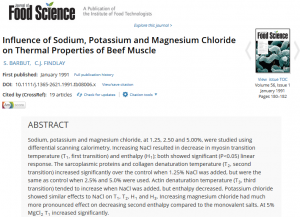Influence of sodium, potassium and magnesium-chloride on thermal-properties of beef muscle
 Sodium, potassium and magnesium chloride, at 1.25, 2.50 and 5.00%, were studied using differential scanning calorimetry. Increasing NaCl resulted in decrease in myosin transition temperature (T1, first transition) and enthalpy (H1); both showed significant (P<0.05) linear response. The sarcoplasmic proteins and collagen denaturation temperature (T2, second transition) increased significantly over the control when 1.25% NaCl was added, but were the same as control when 2.5% and 5.0% were used. Actin denaturation temperature (T3, third transition) tended to increase when NaCl was added, but enthalpy decreased. Potassium chloride showed similar effects to NaCl on T1, T2, H1 and H3. Increasing magnesium chloride had much more pronounced effect on decreasing second enthalpy compared to the monovalent salts. At 5% MgCl2 T1 increased significantly.
Sodium, potassium and magnesium chloride, at 1.25, 2.50 and 5.00%, were studied using differential scanning calorimetry. Increasing NaCl resulted in decrease in myosin transition temperature (T1, first transition) and enthalpy (H1); both showed significant (P<0.05) linear response. The sarcoplasmic proteins and collagen denaturation temperature (T2, second transition) increased significantly over the control when 1.25% NaCl was added, but were the same as control when 2.5% and 5.0% were used. Actin denaturation temperature (T3, third transition) tended to increase when NaCl was added, but enthalpy decreased. Potassium chloride showed similar effects to NaCl on T1, T2, H1 and H3. Increasing magnesium chloride had much more pronounced effect on decreasing second enthalpy compared to the monovalent salts. At 5% MgCl2 T1 increased significantly.
![]()
Barbut, S., & Findlay, C. J. (1991). Influence of sodium, potassium and magnesium-chloride on thermal-properties of beef muscle. Journal of Food Science, 56(1), 180-182. http://dx.doi.org/10.1111/j.1365-2621.1991.tb08006.x